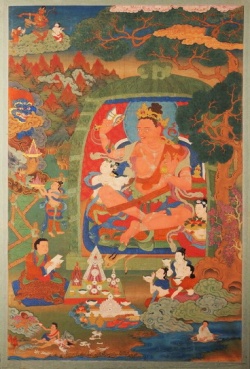Yarlung
by Rachel Pang Survey of History and Significance
Yarlung, located 55 miles SE of Lhasa, is a place that figures prominently in both Tibetan history and the Tibetan identity. Yarlung was home to the first king of Tibet, Nyatri Tsenpo, and remained the capital of the Tibetan empire until it was moved to Lhasa in the seventh century by King Songsten Gampo. The Yarlung Dynasty reached its peak during the military successes of the seventh and eighth centuries and abruptly came to an end in 842 due to the assassination of King Lang Darma’s assassination. This event threw the empire into a century-long period of political fragmentation and chaos. Despite that the Yarlung dynasty would never recover its previous glory, it was nevertheless nostalgically portrayed by Tibetan historiographers as the “Golden Age” of Tibetan history. The tombs of the great Yarlung Emperors are still located in the Yarlung dynasty to this day, and are important destinations of pilgrimage.
Yarlung in the Blue Annals
The word “Yarlung” figures prominently in The Blue Annals, appearing over 50 times. Despite its historical and mythological significance in the Tibetan psyche, it is perhaps surprising that The Blue Annals’ portrayal of the Yarlung is rather understated and devoid of any mythological embellishment. Most of the references to Yarlung in The Blue Annals are entirely in passing, and usually refer to the homeland of a person or the location of an event. For example, people are frequently described as “________ from Yarlung.” Nevertheless, Yarlung seems to be a significant place because almost every prominent Buddhist teacher or seeker of the Dharma in The Blue Annals makes a visit to this place. In other words, like New York in the United States or Paris in France, Yarlung is a necessary pit stop for anyone traveling in Tibet. Perhaps the monumental importance of Yarlung is revealed by the fact that the author does not feel compelled to mythologize it; Yarlung occupied such a solid place in the Tibetan concept of history and geography in 14th century Tibet that the author, Go Lotsawa, did not feel the need to embellish it any further. Yarlung is a marker of identity. Sources
Powers, John. Introduction to Tibetan Buddhism.
The Clear Mirror. Trans. McComas Taylor and Lama Choedak Yuthok.
